Business Process Modelling for University: Challenges, Objectives, and Achievements
VerifiedAdded on 2023/06/03
|21
|2730
|317
AI Summary
This article discusses the challenges faced by a university and how they implemented Business Process Modelling (BPM) to achieve operational excellence. It covers the objectives, process discovery, improvements achieved, and the rationale behind BPM. It also includes diagrams and discussions on the relationship between Enterprise Architecture and BPM, process segments and business entities in BPM, and the distinction between Quality Management, Quality Assurance, and Quality Control.
Contribute Materials
Your contribution can guide someone’s learning journey. Share your
documents today.

BUSINESS PROCESS MODELLING
1
1
Secure Best Marks with AI Grader
Need help grading? Try our AI Grader for instant feedback on your assignments.

Table of Contents
Week 1.............................................................................................................................................2
Week 3.............................................................................................................................................4
Week 4.............................................................................................................................................5
Week 5.............................................................................................................................................5
Week 6 and 7...................................................................................................................................5
Week 8.............................................................................................................................................8
Week 9 and 10...............................................................................................................................10
Week 11.........................................................................................................................................11
References......................................................................................................................................11
2
Week 1.............................................................................................................................................2
Week 3.............................................................................................................................................4
Week 4.............................................................................................................................................5
Week 5.............................................................................................................................................5
Week 6 and 7...................................................................................................................................5
Week 8.............................................................................................................................................8
Week 9 and 10...............................................................................................................................10
Week 11.........................................................................................................................................11
References......................................................................................................................................11
2
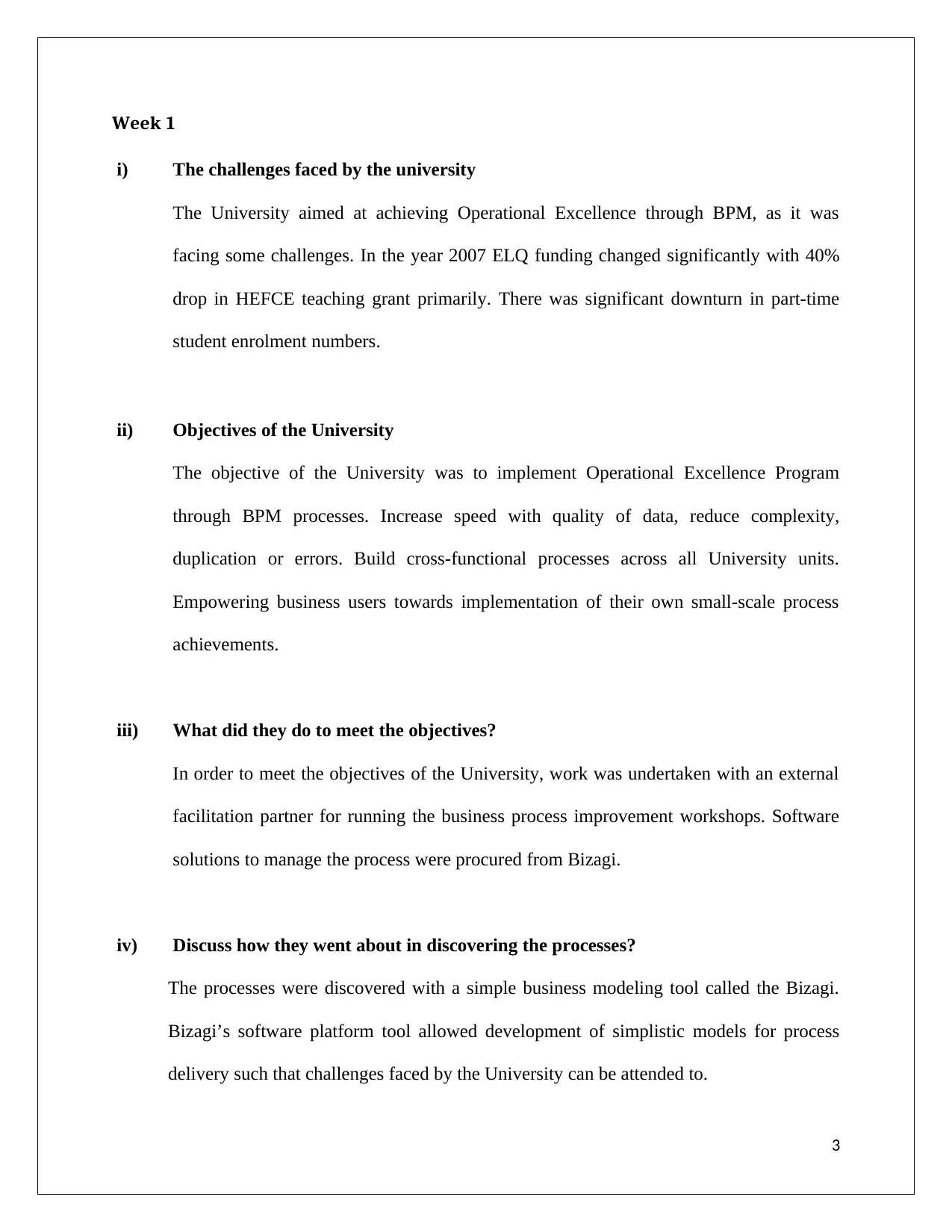
Week 1
i) The challenges faced by the university
The University aimed at achieving Operational Excellence through BPM, as it was
facing some challenges. In the year 2007 ELQ funding changed significantly with 40%
drop in HEFCE teaching grant primarily. There was significant downturn in part-time
student enrolment numbers.
ii) Objectives of the University
The objective of the University was to implement Operational Excellence Program
through BPM processes. Increase speed with quality of data, reduce complexity,
duplication or errors. Build cross-functional processes across all University units.
Empowering business users towards implementation of their own small-scale process
achievements.
iii) What did they do to meet the objectives?
In order to meet the objectives of the University, work was undertaken with an external
facilitation partner for running the business process improvement workshops. Software
solutions to manage the process were procured from Bizagi.
iv) Discuss how they went about in discovering the processes?
The processes were discovered with a simple business modeling tool called the Bizagi.
Bizagi’s software platform tool allowed development of simplistic models for process
delivery such that challenges faced by the University can be attended to.
3
i) The challenges faced by the university
The University aimed at achieving Operational Excellence through BPM, as it was
facing some challenges. In the year 2007 ELQ funding changed significantly with 40%
drop in HEFCE teaching grant primarily. There was significant downturn in part-time
student enrolment numbers.
ii) Objectives of the University
The objective of the University was to implement Operational Excellence Program
through BPM processes. Increase speed with quality of data, reduce complexity,
duplication or errors. Build cross-functional processes across all University units.
Empowering business users towards implementation of their own small-scale process
achievements.
iii) What did they do to meet the objectives?
In order to meet the objectives of the University, work was undertaken with an external
facilitation partner for running the business process improvement workshops. Software
solutions to manage the process were procured from Bizagi.
iv) Discuss how they went about in discovering the processes?
The processes were discovered with a simple business modeling tool called the Bizagi.
Bizagi’s software platform tool allowed development of simplistic models for process
delivery such that challenges faced by the University can be attended to.
3
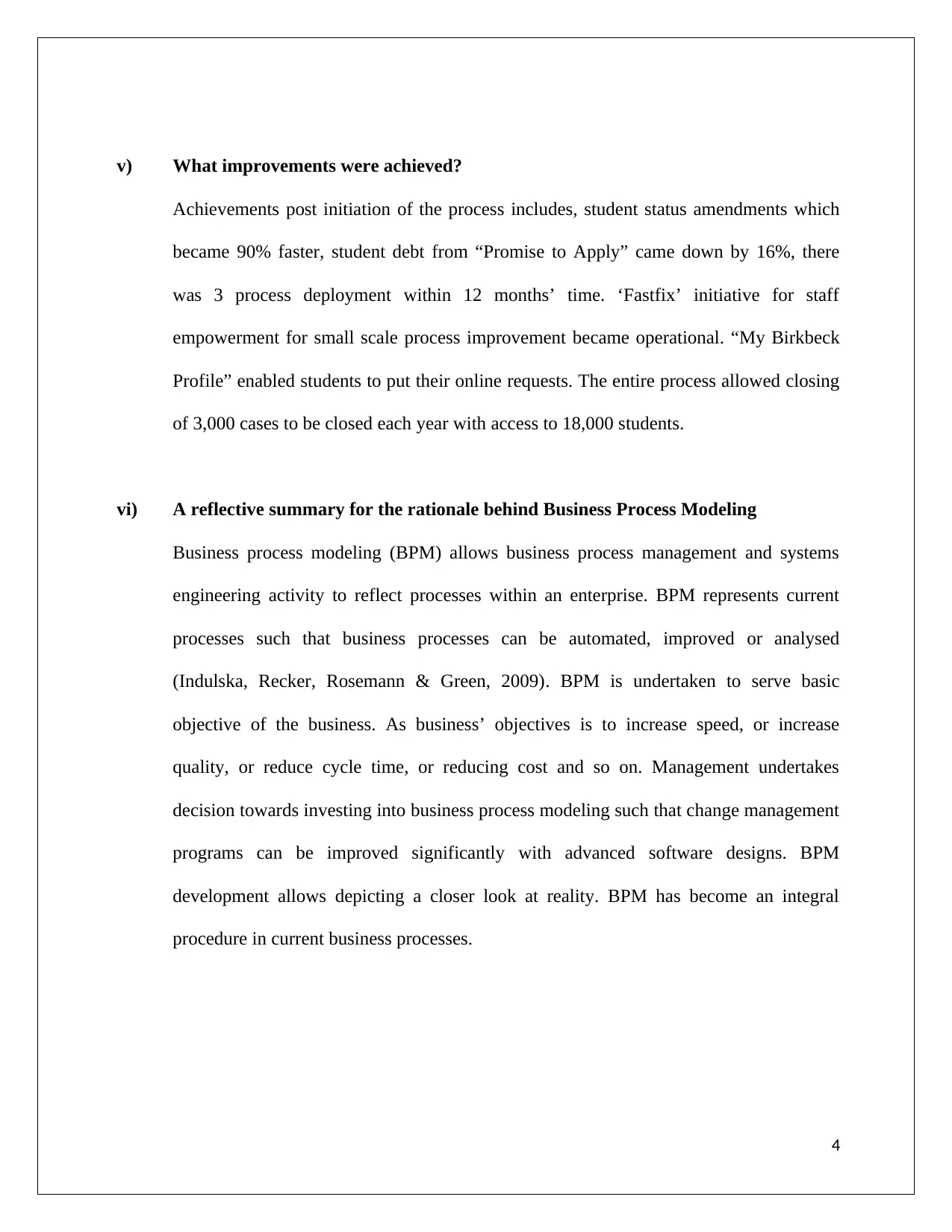
v) What improvements were achieved?
Achievements post initiation of the process includes, student status amendments which
became 90% faster, student debt from “Promise to Apply” came down by 16%, there
was 3 process deployment within 12 months’ time. ‘Fastfix’ initiative for staff
empowerment for small scale process improvement became operational. “My Birkbeck
Profile” enabled students to put their online requests. The entire process allowed closing
of 3,000 cases to be closed each year with access to 18,000 students.
vi) A reflective summary for the rationale behind Business Process Modeling
Business process modeling (BPM) allows business process management and systems
engineering activity to reflect processes within an enterprise. BPM represents current
processes such that business processes can be automated, improved or analysed
(Indulska, Recker, Rosemann & Green, 2009). BPM is undertaken to serve basic
objective of the business. As business’ objectives is to increase speed, or increase
quality, or reduce cycle time, or reducing cost and so on. Management undertakes
decision towards investing into business process modeling such that change management
programs can be improved significantly with advanced software designs. BPM
development allows depicting a closer look at reality. BPM has become an integral
procedure in current business processes.
4
Achievements post initiation of the process includes, student status amendments which
became 90% faster, student debt from “Promise to Apply” came down by 16%, there
was 3 process deployment within 12 months’ time. ‘Fastfix’ initiative for staff
empowerment for small scale process improvement became operational. “My Birkbeck
Profile” enabled students to put their online requests. The entire process allowed closing
of 3,000 cases to be closed each year with access to 18,000 students.
vi) A reflective summary for the rationale behind Business Process Modeling
Business process modeling (BPM) allows business process management and systems
engineering activity to reflect processes within an enterprise. BPM represents current
processes such that business processes can be automated, improved or analysed
(Indulska, Recker, Rosemann & Green, 2009). BPM is undertaken to serve basic
objective of the business. As business’ objectives is to increase speed, or increase
quality, or reduce cycle time, or reducing cost and so on. Management undertakes
decision towards investing into business process modeling such that change management
programs can be improved significantly with advanced software designs. BPM
development allows depicting a closer look at reality. BPM has become an integral
procedure in current business processes.
4
Secure Best Marks with AI Grader
Need help grading? Try our AI Grader for instant feedback on your assignments.
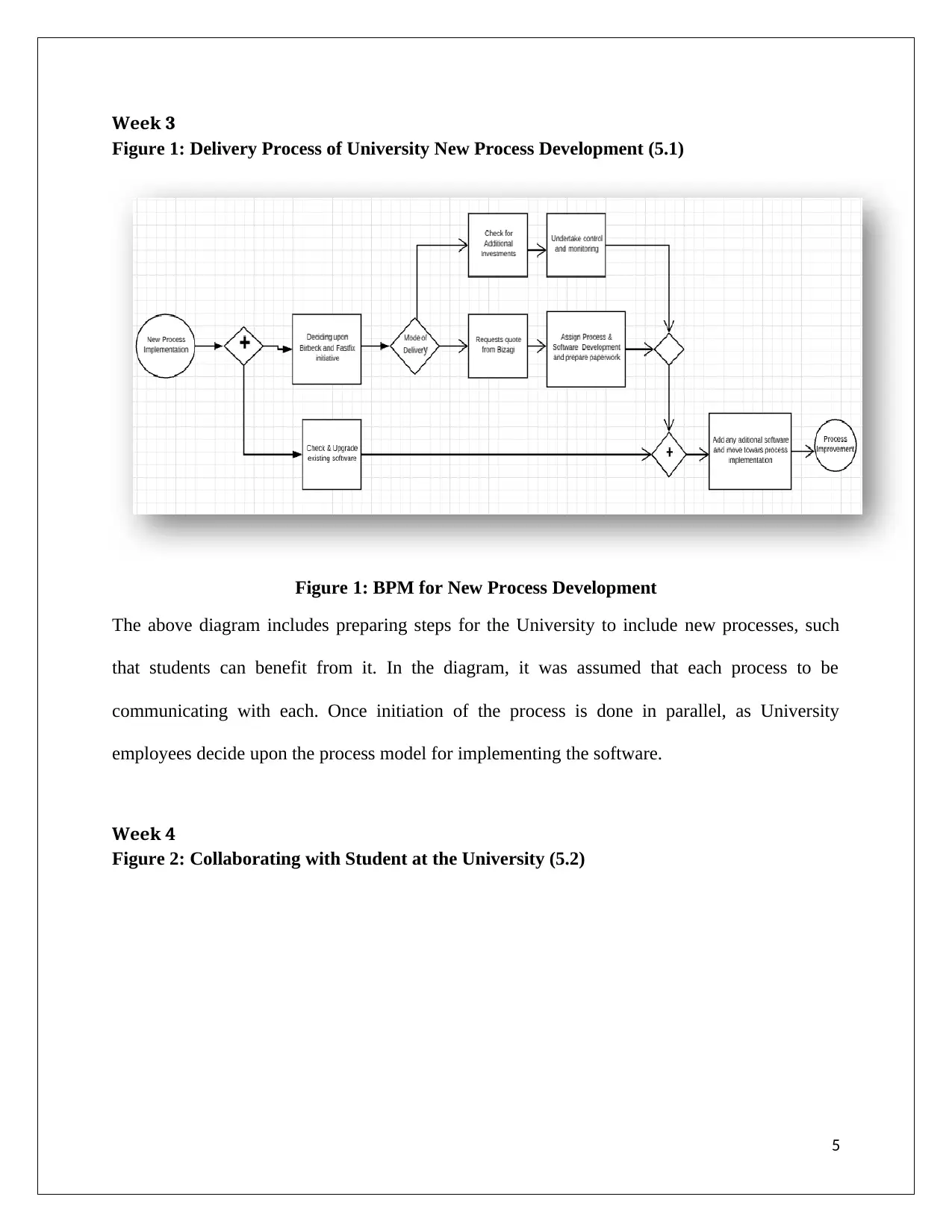
Week 3
Figure 1: Delivery Process of University New Process Development (5.1)
Figure 1: BPM for New Process Development
The above diagram includes preparing steps for the University to include new processes, such
that students can benefit from it. In the diagram, it was assumed that each process to be
communicating with each. Once initiation of the process is done in parallel, as University
employees decide upon the process model for implementing the software.
Week 4
Figure 2: Collaborating with Student at the University (5.2)
5
Figure 1: Delivery Process of University New Process Development (5.1)
Figure 1: BPM for New Process Development
The above diagram includes preparing steps for the University to include new processes, such
that students can benefit from it. In the diagram, it was assumed that each process to be
communicating with each. Once initiation of the process is done in parallel, as University
employees decide upon the process model for implementing the software.
Week 4
Figure 2: Collaborating with Student at the University (5.2)
5

Figure 2: Application at the University
The figure above depicts Business-to-Business-Collaboration model interacts between students
and the University. This model is developed to depict interaction between different departments,
students and software systems and so on. This process reviews the entire application process at
the University.
Figure 3: Order Fulfillment and Procurement (5.3)
6
The figure above depicts Business-to-Business-Collaboration model interacts between students
and the University. This model is developed to depict interaction between different departments,
students and software systems and so on. This process reviews the entire application process at
the University.
Figure 3: Order Fulfillment and Procurement (5.3)
6
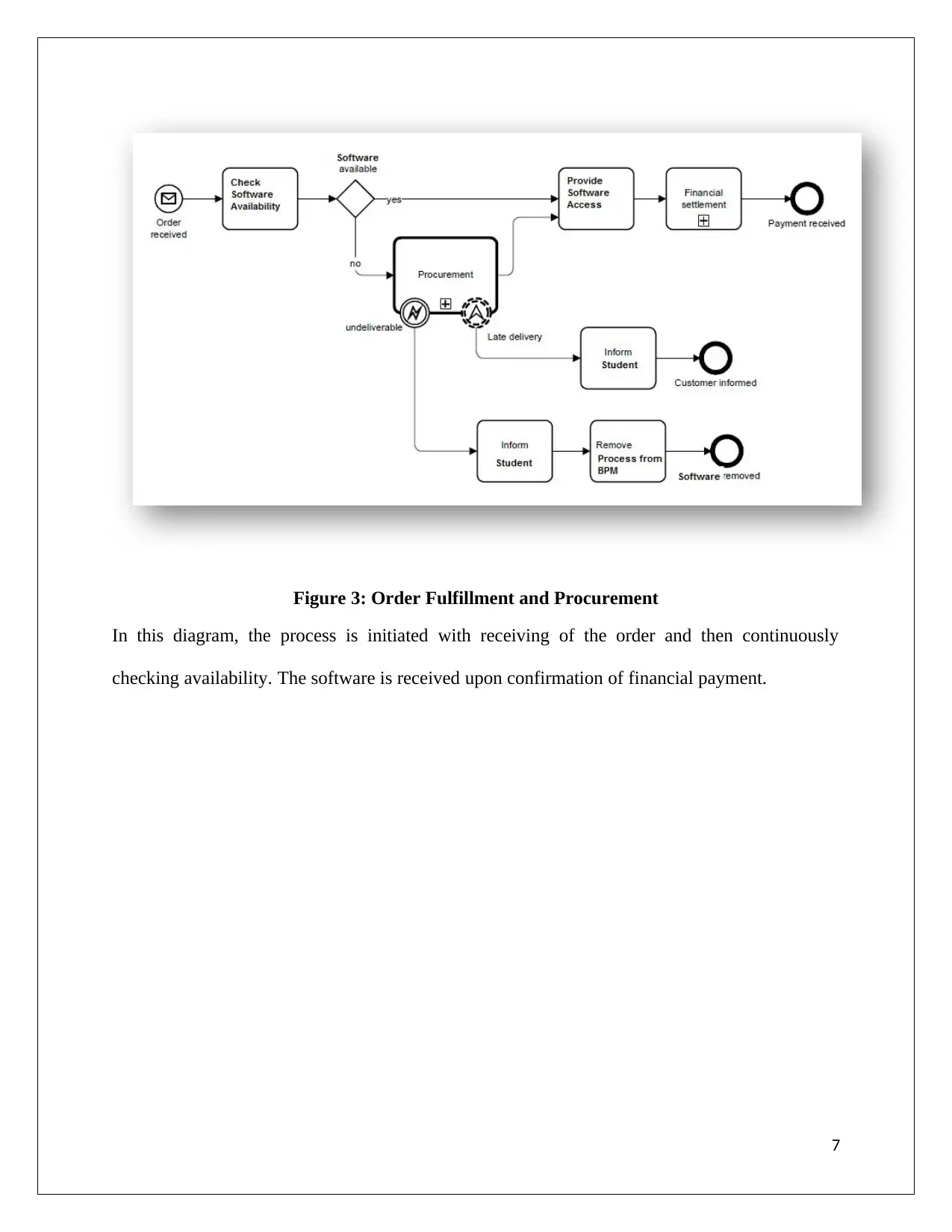
Figure 3: Order Fulfillment and Procurement
In this diagram, the process is initiated with receiving of the order and then continuously
checking availability. The software is received upon confirmation of financial payment.
7
In this diagram, the process is initiated with receiving of the order and then continuously
checking availability. The software is received upon confirmation of financial payment.
7
Paraphrase This Document
Need a fresh take? Get an instant paraphrase of this document with our AI Paraphraser
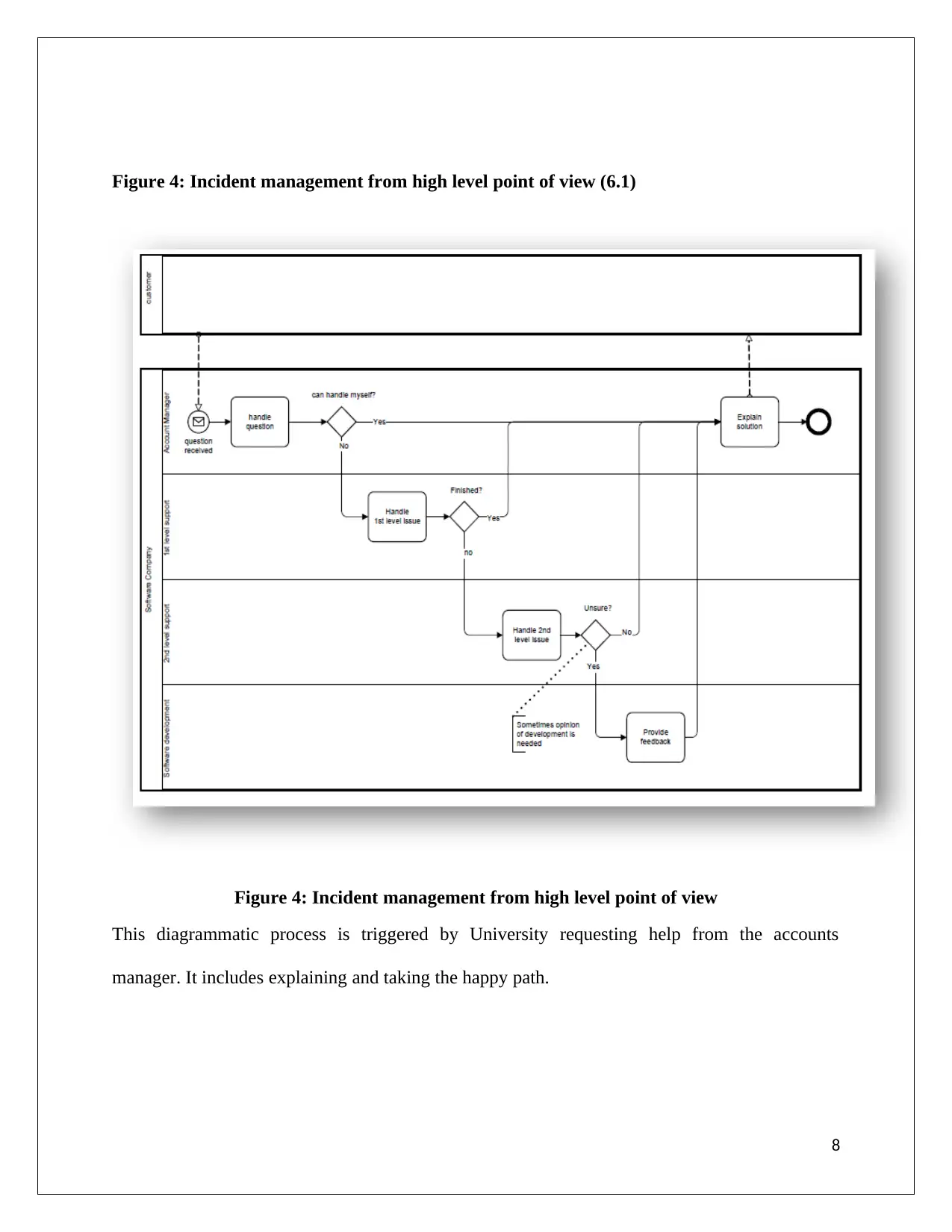
Figure 4: Incident management from high level point of view (6.1)
Figure 4: Incident management from high level point of view
This diagrammatic process is triggered by University requesting help from the accounts
manager. It includes explaining and taking the happy path.
8
Figure 4: Incident management from high level point of view
This diagrammatic process is triggered by University requesting help from the accounts
manager. It includes explaining and taking the happy path.
8
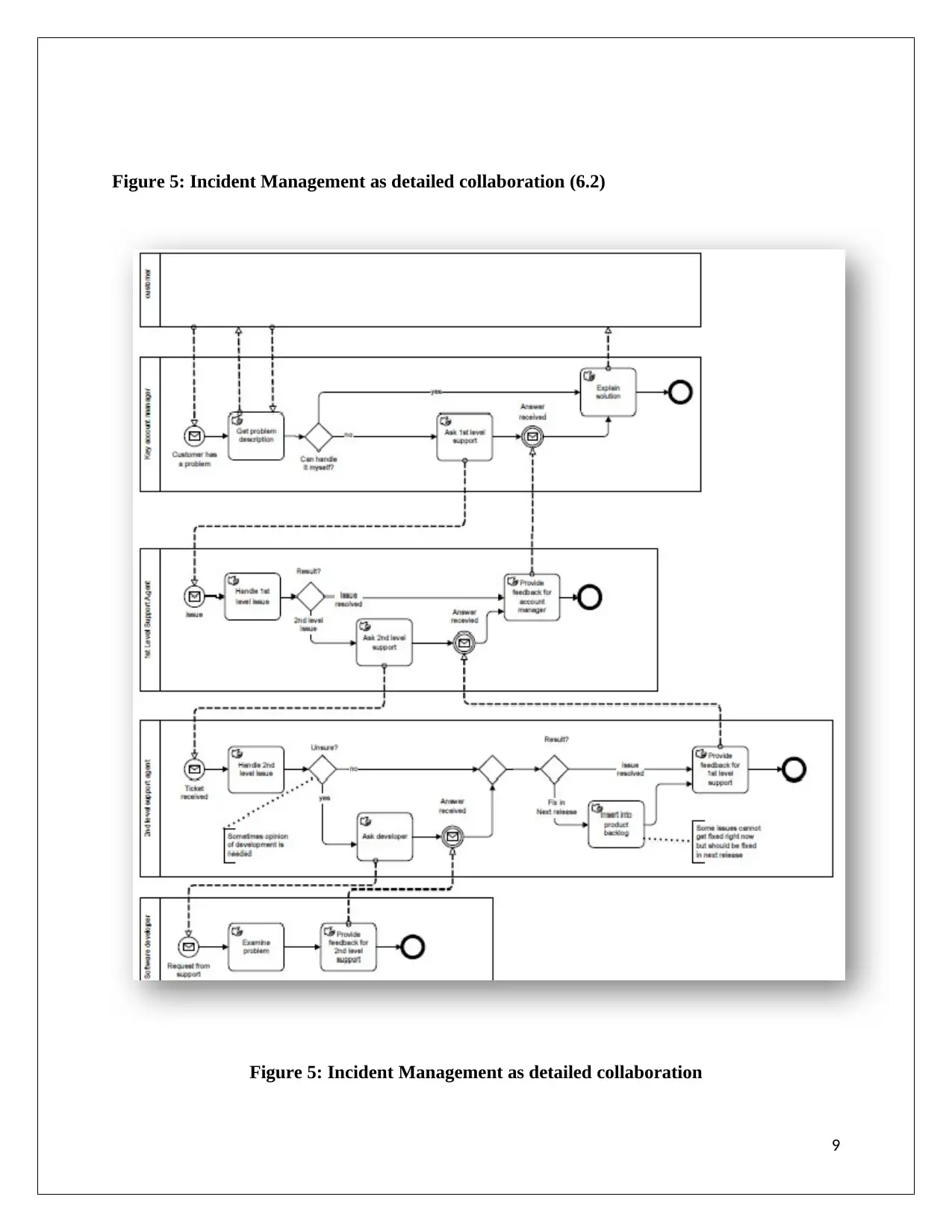
Figure 5: Incident Management as detailed collaboration (6.2)
Figure 5: Incident Management as detailed collaboration
9
Figure 5: Incident Management as detailed collaboration
9
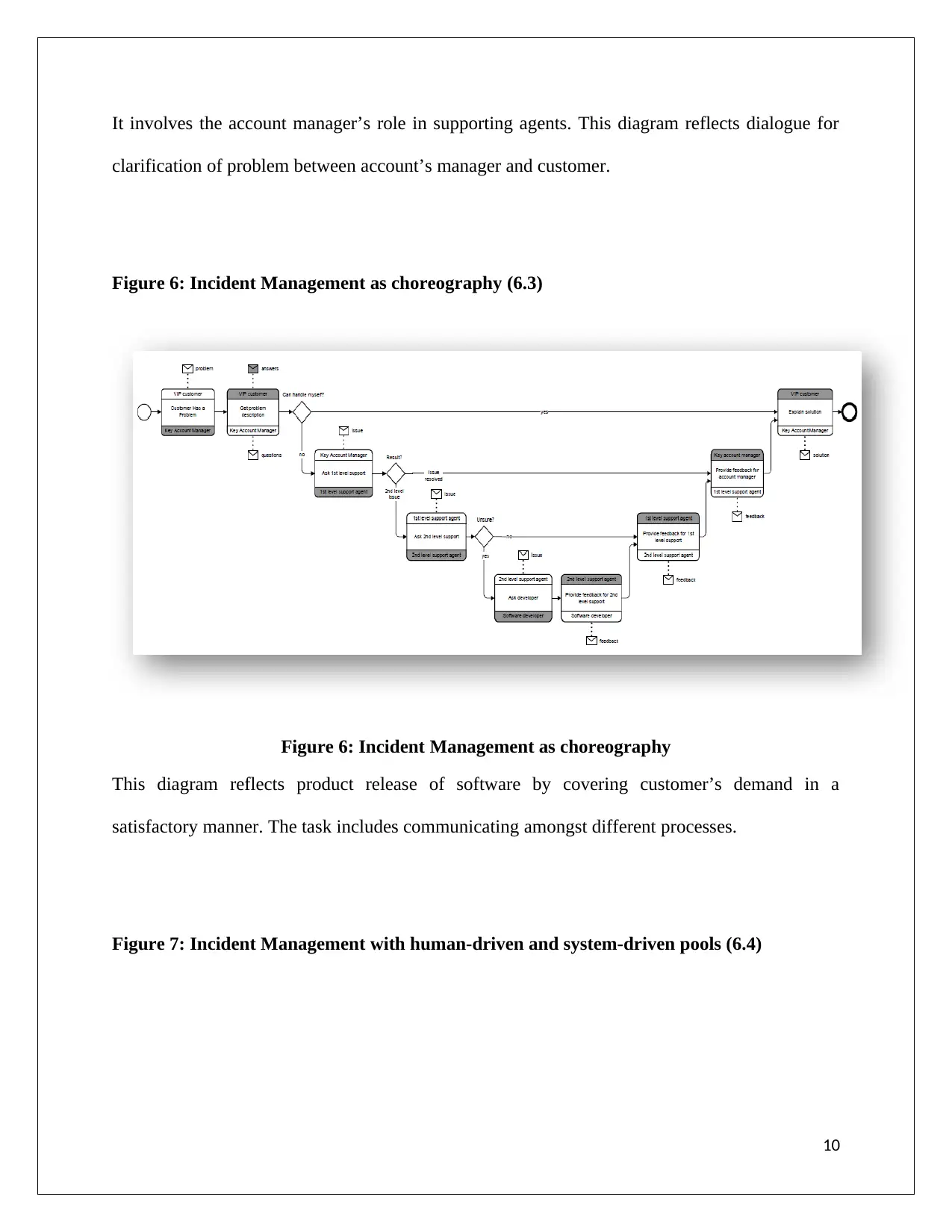
It involves the account manager’s role in supporting agents. This diagram reflects dialogue for
clarification of problem between account’s manager and customer.
Figure 6: Incident Management as choreography (6.3)
Figure 6: Incident Management as choreography
This diagram reflects product release of software by covering customer’s demand in a
satisfactory manner. The task includes communicating amongst different processes.
Figure 7: Incident Management with human-driven and system-driven pools (6.4)
10
clarification of problem between account’s manager and customer.
Figure 6: Incident Management as choreography (6.3)
Figure 6: Incident Management as choreography
This diagram reflects product release of software by covering customer’s demand in a
satisfactory manner. The task includes communicating amongst different processes.
Figure 7: Incident Management with human-driven and system-driven pools (6.4)
10
Secure Best Marks with AI Grader
Need help grading? Try our AI Grader for instant feedback on your assignments.
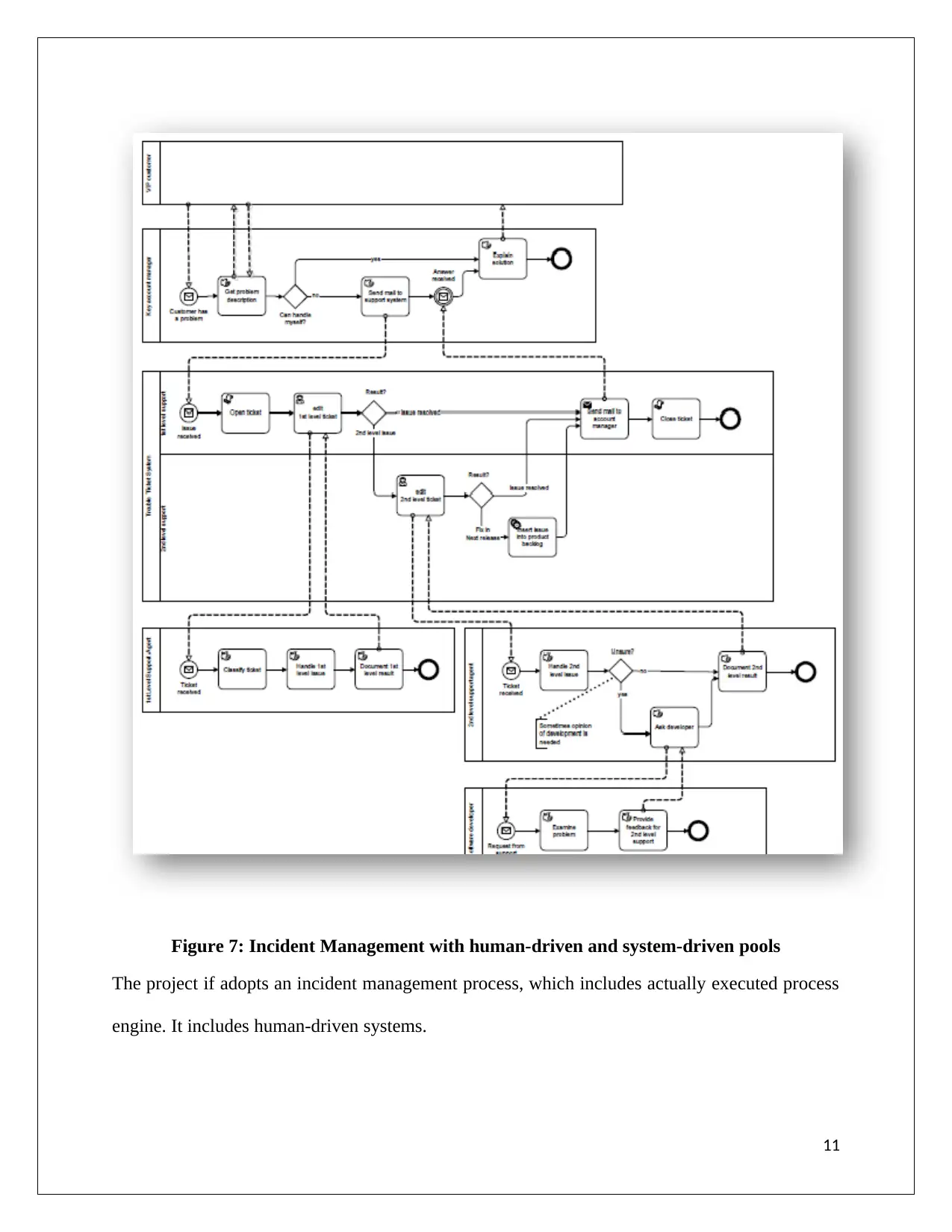
Figure 7: Incident Management with human-driven and system-driven pools
The project if adopts an incident management process, which includes actually executed process
engine. It includes human-driven systems.
11
The project if adopts an incident management process, which includes actually executed process
engine. It includes human-driven systems.
11
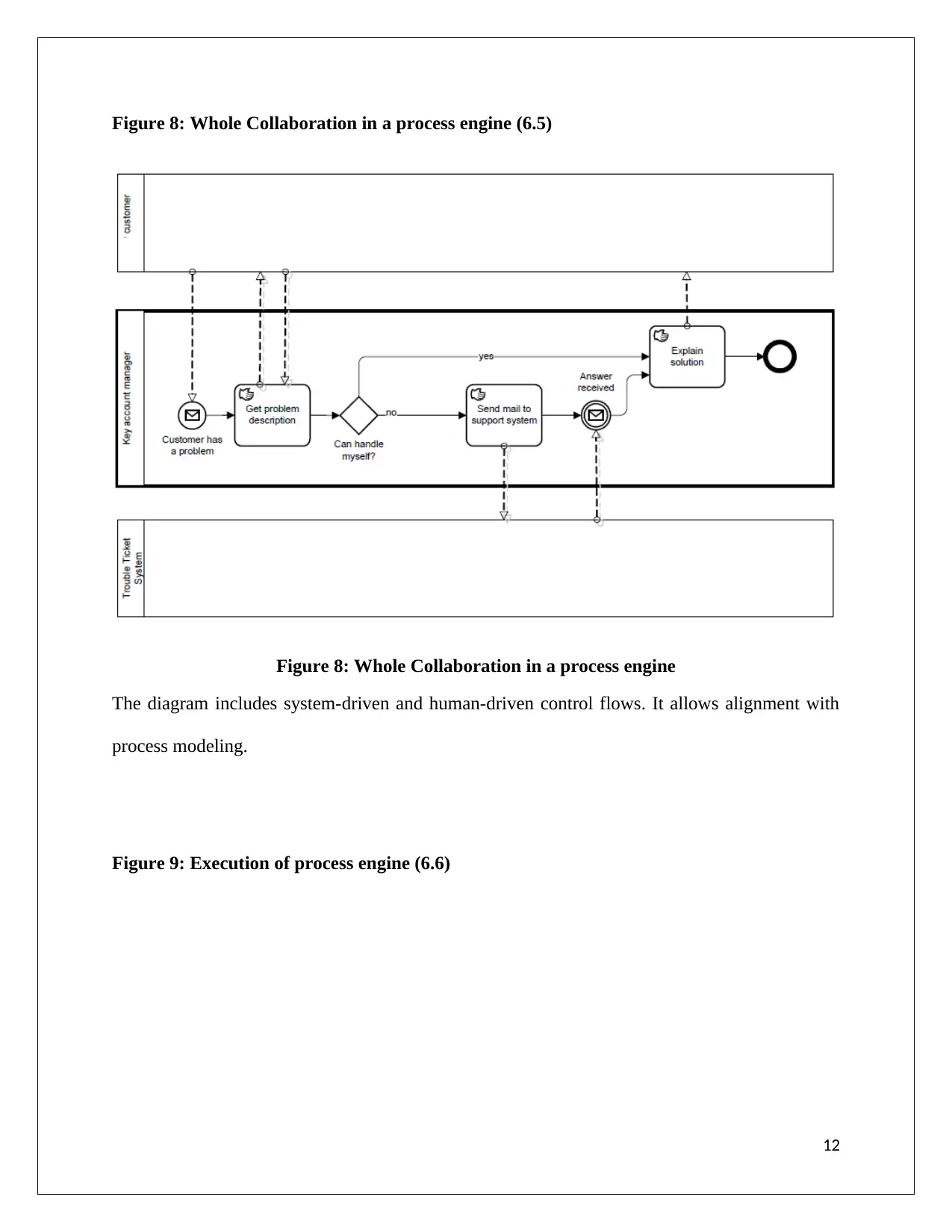
Figure 8: Whole Collaboration in a process engine (6.5)
Figure 8: Whole Collaboration in a process engine
The diagram includes system-driven and human-driven control flows. It allows alignment with
process modeling.
Figure 9: Execution of process engine (6.6)
12
Figure 8: Whole Collaboration in a process engine
The diagram includes system-driven and human-driven control flows. It allows alignment with
process modeling.
Figure 9: Execution of process engine (6.6)
12
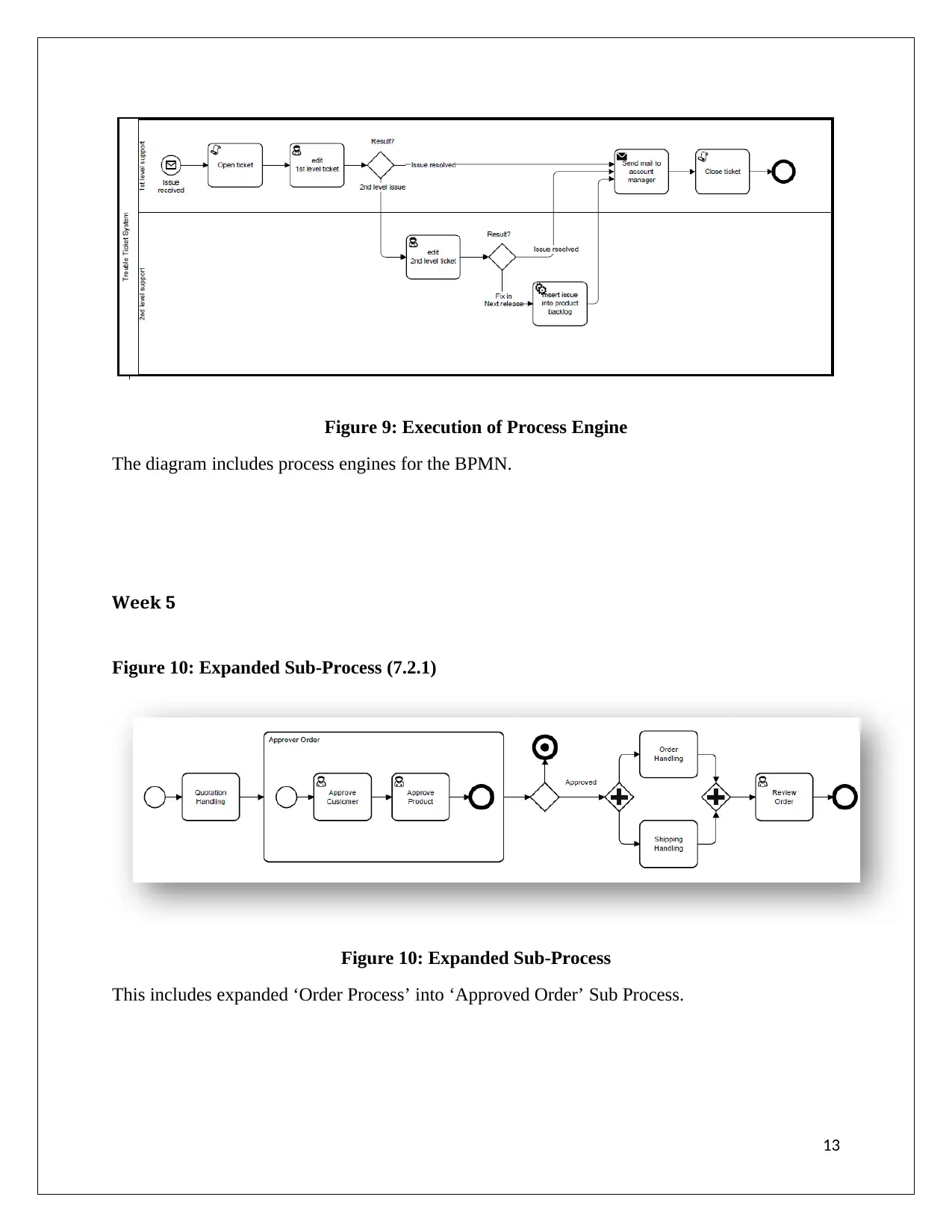
Figure 9: Execution of Process Engine
The diagram includes process engines for the BPMN.
Week 5
Figure 10: Expanded Sub-Process (7.2.1)
Figure 10: Expanded Sub-Process
This includes expanded ‘Order Process’ into ‘Approved Order’ Sub Process.
13
The diagram includes process engines for the BPMN.
Week 5
Figure 10: Expanded Sub-Process (7.2.1)
Figure 10: Expanded Sub-Process
This includes expanded ‘Order Process’ into ‘Approved Order’ Sub Process.
13
Paraphrase This Document
Need a fresh take? Get an instant paraphrase of this document with our AI Paraphraser
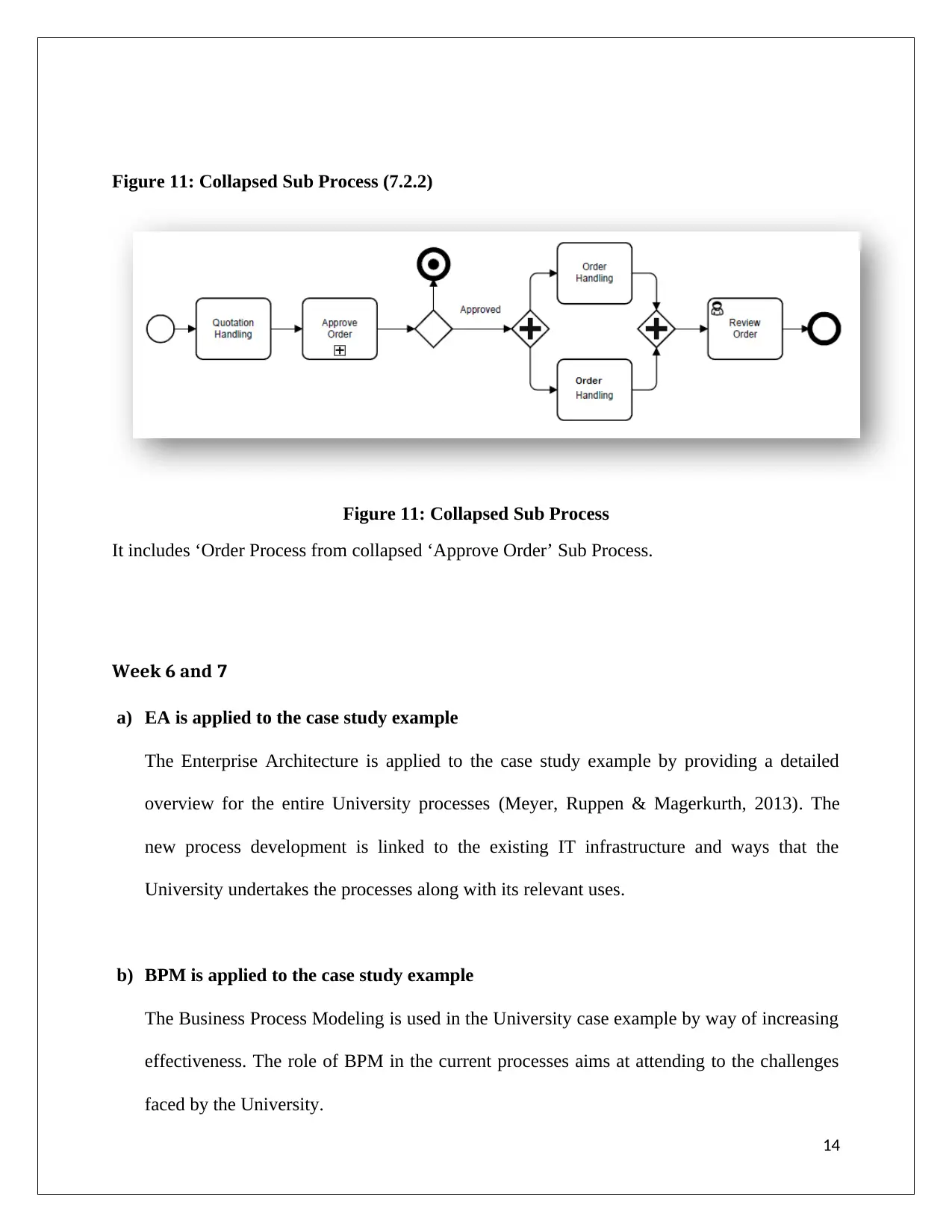
Figure 11: Collapsed Sub Process (7.2.2)
Figure 11: Collapsed Sub Process
It includes ‘Order Process from collapsed ‘Approve Order’ Sub Process.
Week 6 and 7
a) EA is applied to the case study example
The Enterprise Architecture is applied to the case study example by providing a detailed
overview for the entire University processes (Meyer, Ruppen & Magerkurth, 2013). The
new process development is linked to the existing IT infrastructure and ways that the
University undertakes the processes along with its relevant uses.
b) BPM is applied to the case study example
The Business Process Modeling is used in the University case example by way of increasing
effectiveness. The role of BPM in the current processes aims at attending to the challenges
faced by the University.
14
Figure 11: Collapsed Sub Process
It includes ‘Order Process from collapsed ‘Approve Order’ Sub Process.
Week 6 and 7
a) EA is applied to the case study example
The Enterprise Architecture is applied to the case study example by providing a detailed
overview for the entire University processes (Meyer, Ruppen & Magerkurth, 2013). The
new process development is linked to the existing IT infrastructure and ways that the
University undertakes the processes along with its relevant uses.
b) BPM is applied to the case study example
The Business Process Modeling is used in the University case example by way of increasing
effectiveness. The role of BPM in the current processes aims at attending to the challenges
faced by the University.
14
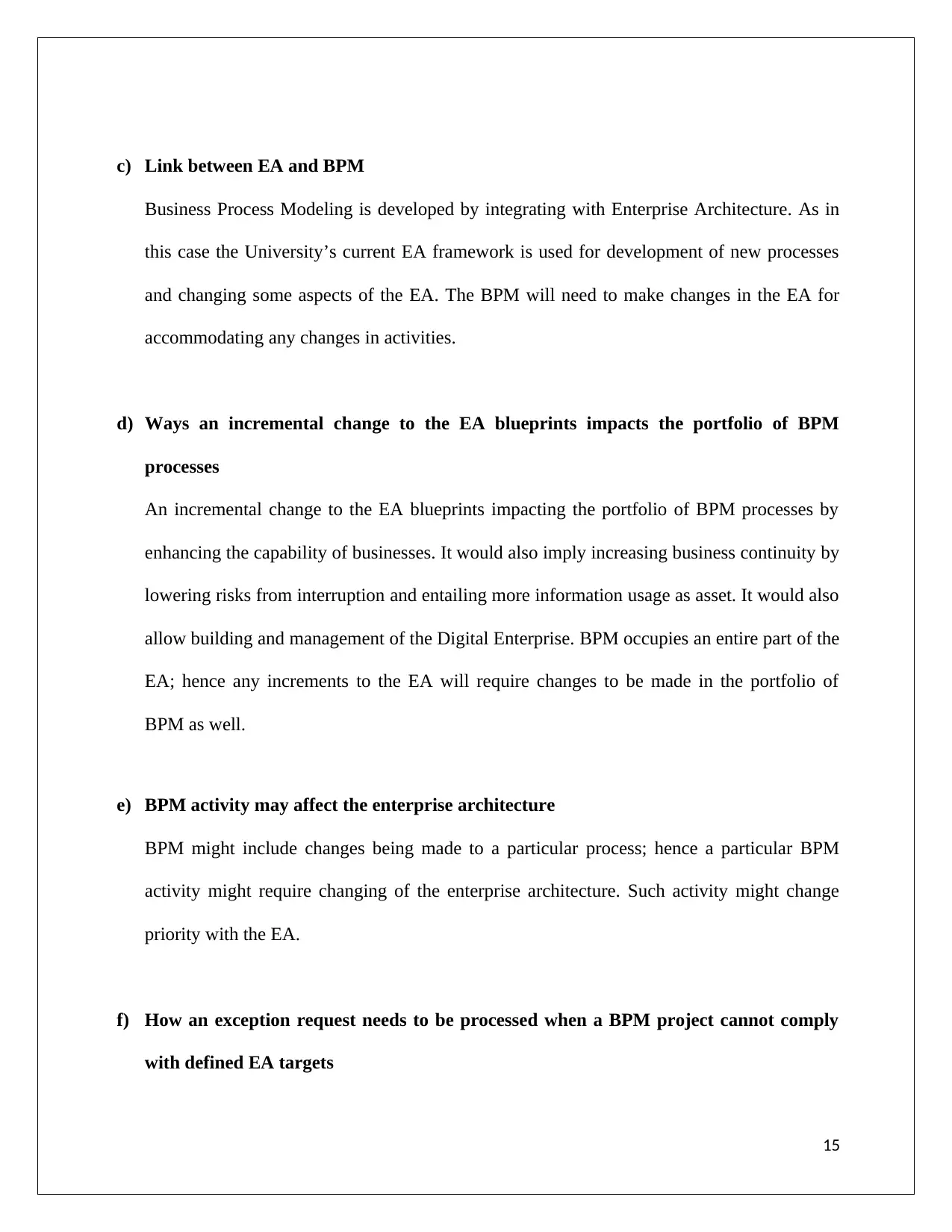
c) Link between EA and BPM
Business Process Modeling is developed by integrating with Enterprise Architecture. As in
this case the University’s current EA framework is used for development of new processes
and changing some aspects of the EA. The BPM will need to make changes in the EA for
accommodating any changes in activities.
d) Ways an incremental change to the EA blueprints impacts the portfolio of BPM
processes
An incremental change to the EA blueprints impacting the portfolio of BPM processes by
enhancing the capability of businesses. It would also imply increasing business continuity by
lowering risks from interruption and entailing more information usage as asset. It would also
allow building and management of the Digital Enterprise. BPM occupies an entire part of the
EA; hence any increments to the EA will require changes to be made in the portfolio of
BPM as well.
e) BPM activity may affect the enterprise architecture
BPM might include changes being made to a particular process; hence a particular BPM
activity might require changing of the enterprise architecture. Such activity might change
priority with the EA.
f) How an exception request needs to be processed when a BPM project cannot comply
with defined EA targets
15
Business Process Modeling is developed by integrating with Enterprise Architecture. As in
this case the University’s current EA framework is used for development of new processes
and changing some aspects of the EA. The BPM will need to make changes in the EA for
accommodating any changes in activities.
d) Ways an incremental change to the EA blueprints impacts the portfolio of BPM
processes
An incremental change to the EA blueprints impacting the portfolio of BPM processes by
enhancing the capability of businesses. It would also imply increasing business continuity by
lowering risks from interruption and entailing more information usage as asset. It would also
allow building and management of the Digital Enterprise. BPM occupies an entire part of the
EA; hence any increments to the EA will require changes to be made in the portfolio of
BPM as well.
e) BPM activity may affect the enterprise architecture
BPM might include changes being made to a particular process; hence a particular BPM
activity might require changing of the enterprise architecture. Such activity might change
priority with the EA.
f) How an exception request needs to be processed when a BPM project cannot comply
with defined EA targets
15
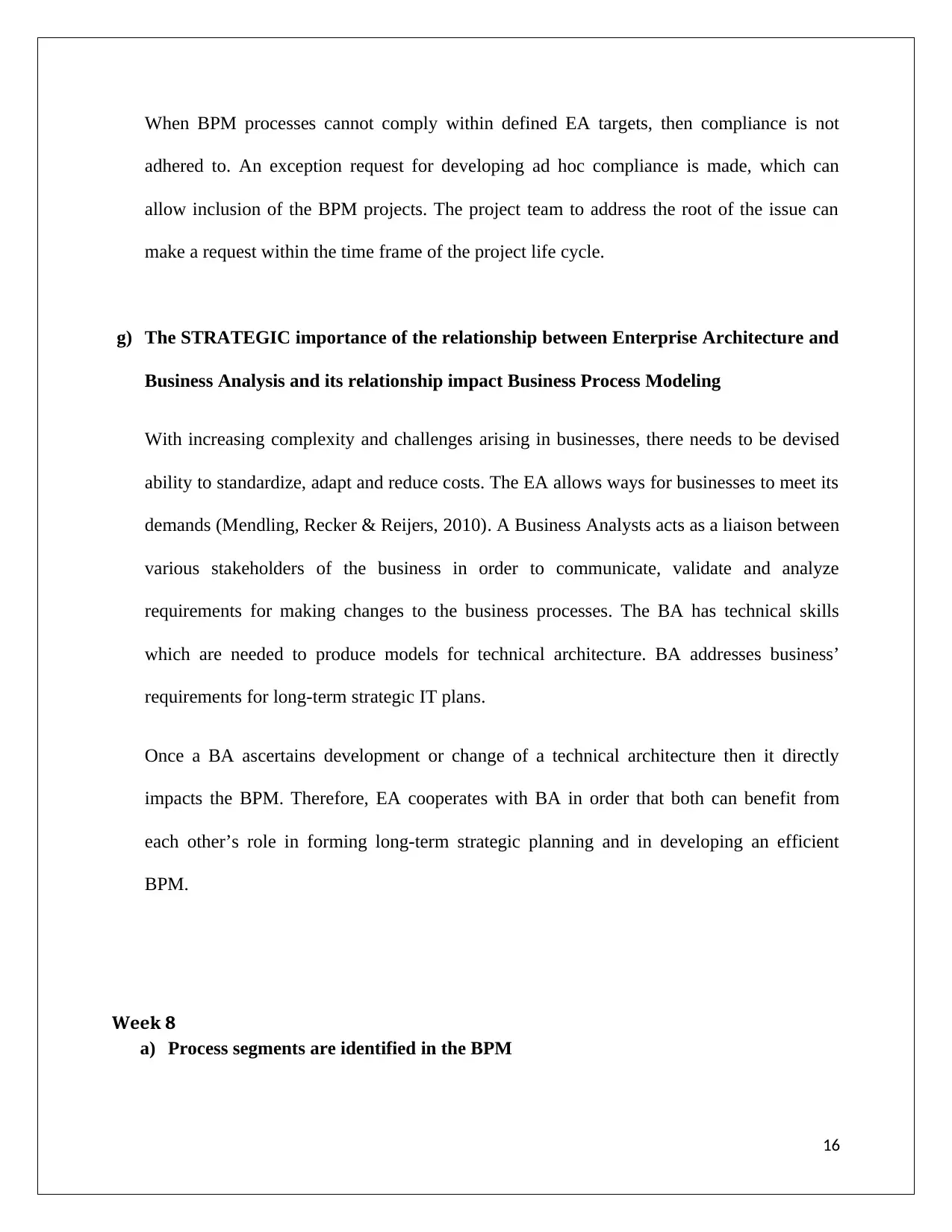
When BPM processes cannot comply within defined EA targets, then compliance is not
adhered to. An exception request for developing ad hoc compliance is made, which can
allow inclusion of the BPM projects. The project team to address the root of the issue can
make a request within the time frame of the project life cycle.
g) The STRATEGIC importance of the relationship between Enterprise Architecture and
Business Analysis and its relationship impact Business Process Modeling
With increasing complexity and challenges arising in businesses, there needs to be devised
ability to standardize, adapt and reduce costs. The EA allows ways for businesses to meet its
demands (Mendling, Recker & Reijers, 2010). A Business Analysts acts as a liaison between
various stakeholders of the business in order to communicate, validate and analyze
requirements for making changes to the business processes. The BA has technical skills
which are needed to produce models for technical architecture. BA addresses business’
requirements for long-term strategic IT plans.
Once a BA ascertains development or change of a technical architecture then it directly
impacts the BPM. Therefore, EA cooperates with BA in order that both can benefit from
each other’s role in forming long-term strategic planning and in developing an efficient
BPM.
Week 8
a) Process segments are identified in the BPM
16
adhered to. An exception request for developing ad hoc compliance is made, which can
allow inclusion of the BPM projects. The project team to address the root of the issue can
make a request within the time frame of the project life cycle.
g) The STRATEGIC importance of the relationship between Enterprise Architecture and
Business Analysis and its relationship impact Business Process Modeling
With increasing complexity and challenges arising in businesses, there needs to be devised
ability to standardize, adapt and reduce costs. The EA allows ways for businesses to meet its
demands (Mendling, Recker & Reijers, 2010). A Business Analysts acts as a liaison between
various stakeholders of the business in order to communicate, validate and analyze
requirements for making changes to the business processes. The BA has technical skills
which are needed to produce models for technical architecture. BA addresses business’
requirements for long-term strategic IT plans.
Once a BA ascertains development or change of a technical architecture then it directly
impacts the BPM. Therefore, EA cooperates with BA in order that both can benefit from
each other’s role in forming long-term strategic planning and in developing an efficient
BPM.
Week 8
a) Process segments are identified in the BPM
16
Secure Best Marks with AI Grader
Need help grading? Try our AI Grader for instant feedback on your assignments.
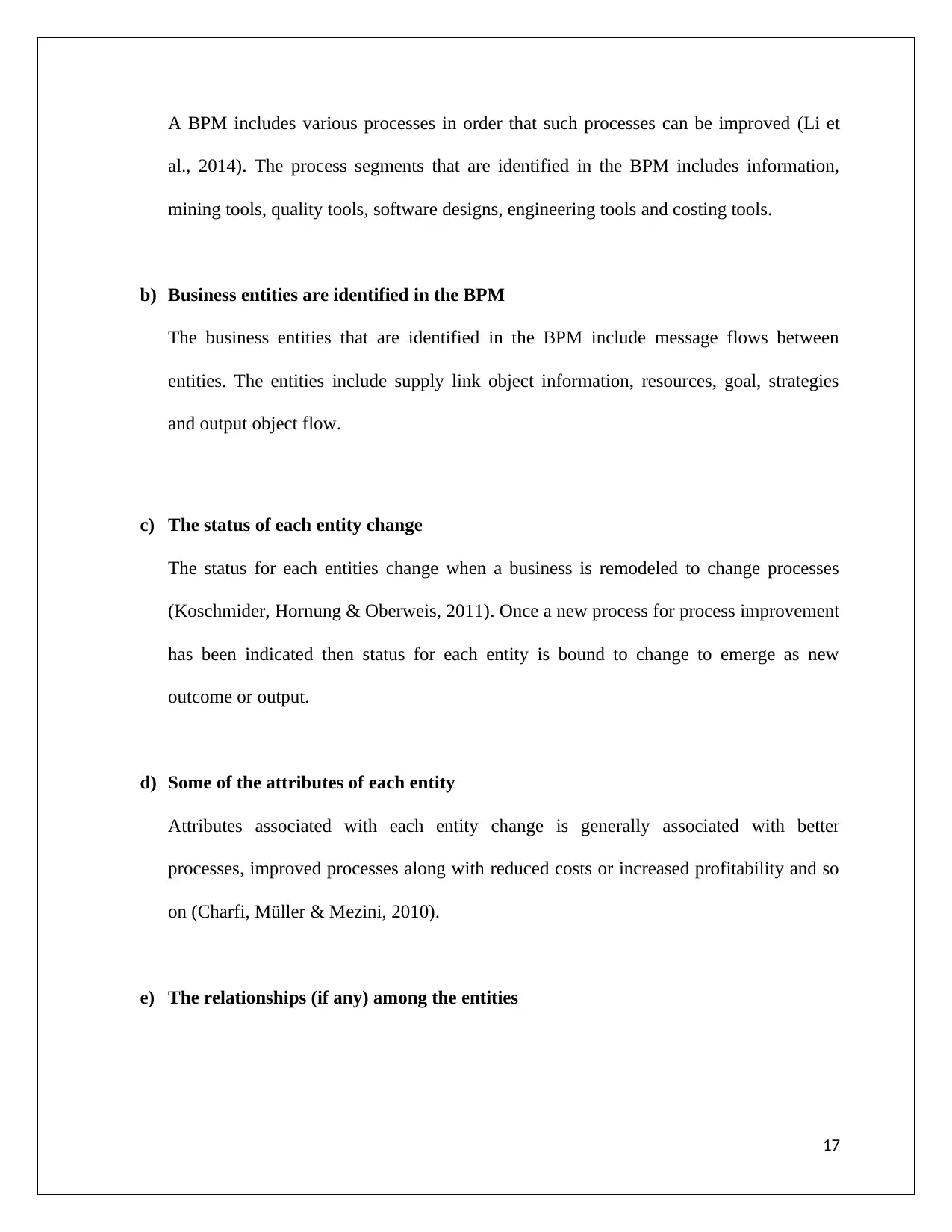
A BPM includes various processes in order that such processes can be improved (Li et
al., 2014). The process segments that are identified in the BPM includes information,
mining tools, quality tools, software designs, engineering tools and costing tools.
b) Business entities are identified in the BPM
The business entities that are identified in the BPM include message flows between
entities. The entities include supply link object information, resources, goal, strategies
and output object flow.
c) The status of each entity change
The status for each entities change when a business is remodeled to change processes
(Koschmider, Hornung & Oberweis, 2011). Once a new process for process improvement
has been indicated then status for each entity is bound to change to emerge as new
outcome or output.
d) Some of the attributes of each entity
Attributes associated with each entity change is generally associated with better
processes, improved processes along with reduced costs or increased profitability and so
on (Charfi, Müller & Mezini, 2010).
e) The relationships (if any) among the entities
17
al., 2014). The process segments that are identified in the BPM includes information,
mining tools, quality tools, software designs, engineering tools and costing tools.
b) Business entities are identified in the BPM
The business entities that are identified in the BPM include message flows between
entities. The entities include supply link object information, resources, goal, strategies
and output object flow.
c) The status of each entity change
The status for each entities change when a business is remodeled to change processes
(Koschmider, Hornung & Oberweis, 2011). Once a new process for process improvement
has been indicated then status for each entity is bound to change to emerge as new
outcome or output.
d) Some of the attributes of each entity
Attributes associated with each entity change is generally associated with better
processes, improved processes along with reduced costs or increased profitability and so
on (Charfi, Müller & Mezini, 2010).
e) The relationships (if any) among the entities
17

The relationship amongst the entities can be depicted as an input process being
transformed into output process, linked to the goal (Recker, Rosemann, Indulska &
Green, 2009). The link depicts the flow of various events from one end to the other.
f) Estimate the size of BPM
The size of the BPM is identifiable with the project scope. The number of steps present in
single process, with lengths of the forms associated and integration to the business and
application is usually the size of the BPM (Weske, 2012). In order to estimate the size for
the University BPM, the goal for process improvement is estimated then from As-Is
business processes the next level of As-Is condition is estimated in the process map. As in
the University project, there are approximately 3 steps included.
Week 9 and 10
Distinction between the Quality Management from Quality Assurance and Quality Control
(Testing). The advantages of each of these functions in enhancing the Quality of your
BPMs. Ensure your answer includes testing for non-functional aspects of your BPM.
Quality management (QM) has four main components comprising of quality planning, quality
control, quality assurance and quality improvement. Quality management encompasses not only
product or services, rather includes ways and means to achieve them as well (Laguna &
Marklund, 2013). Quality Assurance (QA) is a process that deliberates regarding achievement of
quality and Quality Control (QC) is focused on fulfilling a quality request. None of the two
18
transformed into output process, linked to the goal (Recker, Rosemann, Indulska &
Green, 2009). The link depicts the flow of various events from one end to the other.
f) Estimate the size of BPM
The size of the BPM is identifiable with the project scope. The number of steps present in
single process, with lengths of the forms associated and integration to the business and
application is usually the size of the BPM (Weske, 2012). In order to estimate the size for
the University BPM, the goal for process improvement is estimated then from As-Is
business processes the next level of As-Is condition is estimated in the process map. As in
the University project, there are approximately 3 steps included.
Week 9 and 10
Distinction between the Quality Management from Quality Assurance and Quality Control
(Testing). The advantages of each of these functions in enhancing the Quality of your
BPMs. Ensure your answer includes testing for non-functional aspects of your BPM.
Quality management (QM) has four main components comprising of quality planning, quality
control, quality assurance and quality improvement. Quality management encompasses not only
product or services, rather includes ways and means to achieve them as well (Laguna &
Marklund, 2013). Quality Assurance (QA) is a process that deliberates regarding achievement of
quality and Quality Control (QC) is focused on fulfilling a quality request. None of the two
18
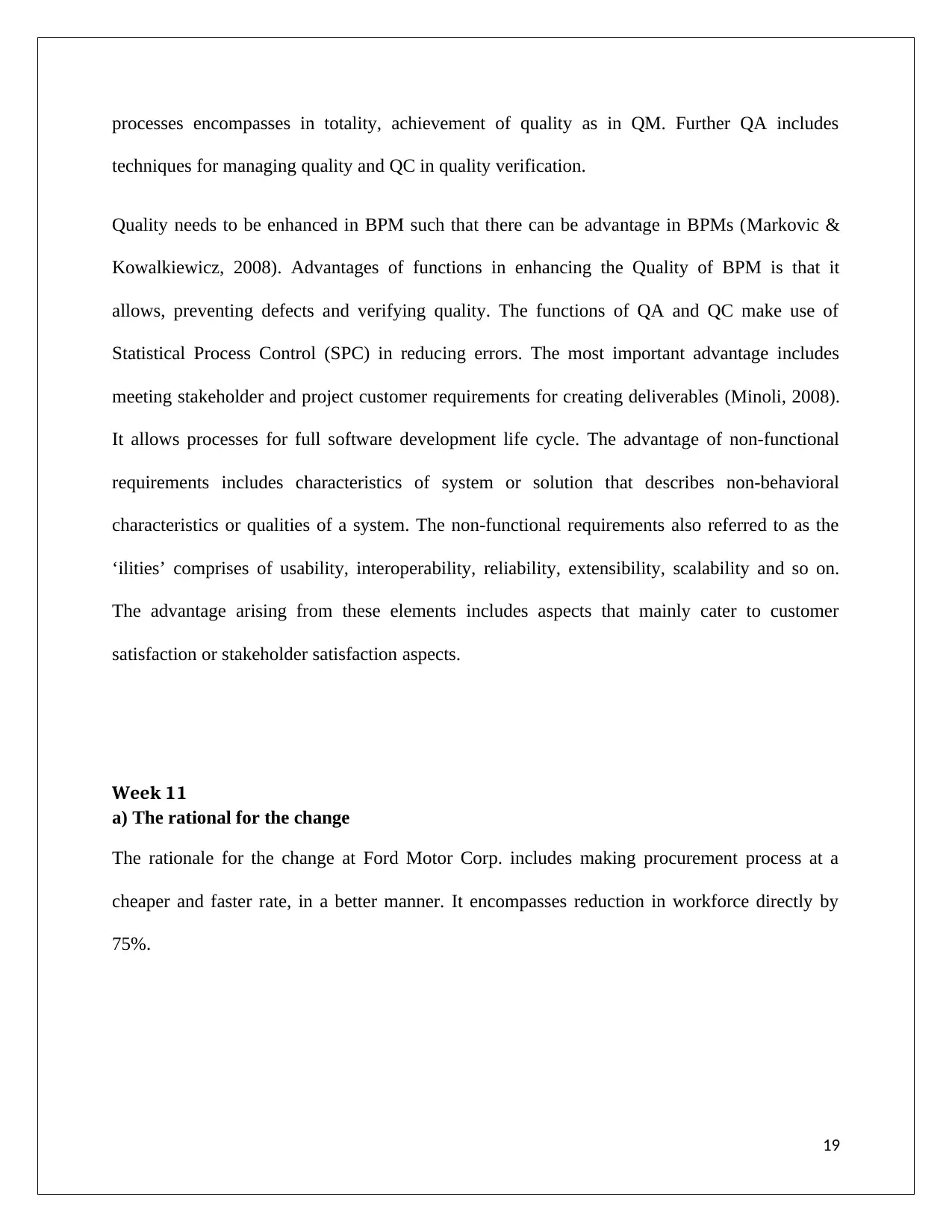
processes encompasses in totality, achievement of quality as in QM. Further QA includes
techniques for managing quality and QC in quality verification.
Quality needs to be enhanced in BPM such that there can be advantage in BPMs (Markovic &
Kowalkiewicz, 2008). Advantages of functions in enhancing the Quality of BPM is that it
allows, preventing defects and verifying quality. The functions of QA and QC make use of
Statistical Process Control (SPC) in reducing errors. The most important advantage includes
meeting stakeholder and project customer requirements for creating deliverables (Minoli, 2008).
It allows processes for full software development life cycle. The advantage of non-functional
requirements includes characteristics of system or solution that describes non-behavioral
characteristics or qualities of a system. The non-functional requirements also referred to as the
‘ilities’ comprises of usability, interoperability, reliability, extensibility, scalability and so on.
The advantage arising from these elements includes aspects that mainly cater to customer
satisfaction or stakeholder satisfaction aspects.
Week 11
a) The rational for the change
The rationale for the change at Ford Motor Corp. includes making procurement process at a
cheaper and faster rate, in a better manner. It encompasses reduction in workforce directly by
75%.
19
techniques for managing quality and QC in quality verification.
Quality needs to be enhanced in BPM such that there can be advantage in BPMs (Markovic &
Kowalkiewicz, 2008). Advantages of functions in enhancing the Quality of BPM is that it
allows, preventing defects and verifying quality. The functions of QA and QC make use of
Statistical Process Control (SPC) in reducing errors. The most important advantage includes
meeting stakeholder and project customer requirements for creating deliverables (Minoli, 2008).
It allows processes for full software development life cycle. The advantage of non-functional
requirements includes characteristics of system or solution that describes non-behavioral
characteristics or qualities of a system. The non-functional requirements also referred to as the
‘ilities’ comprises of usability, interoperability, reliability, extensibility, scalability and so on.
The advantage arising from these elements includes aspects that mainly cater to customer
satisfaction or stakeholder satisfaction aspects.
Week 11
a) The rational for the change
The rationale for the change at Ford Motor Corp. includes making procurement process at a
cheaper and faster rate, in a better manner. It encompasses reduction in workforce directly by
75%.
19
Paraphrase This Document
Need a fresh take? Get an instant paraphrase of this document with our AI Paraphraser
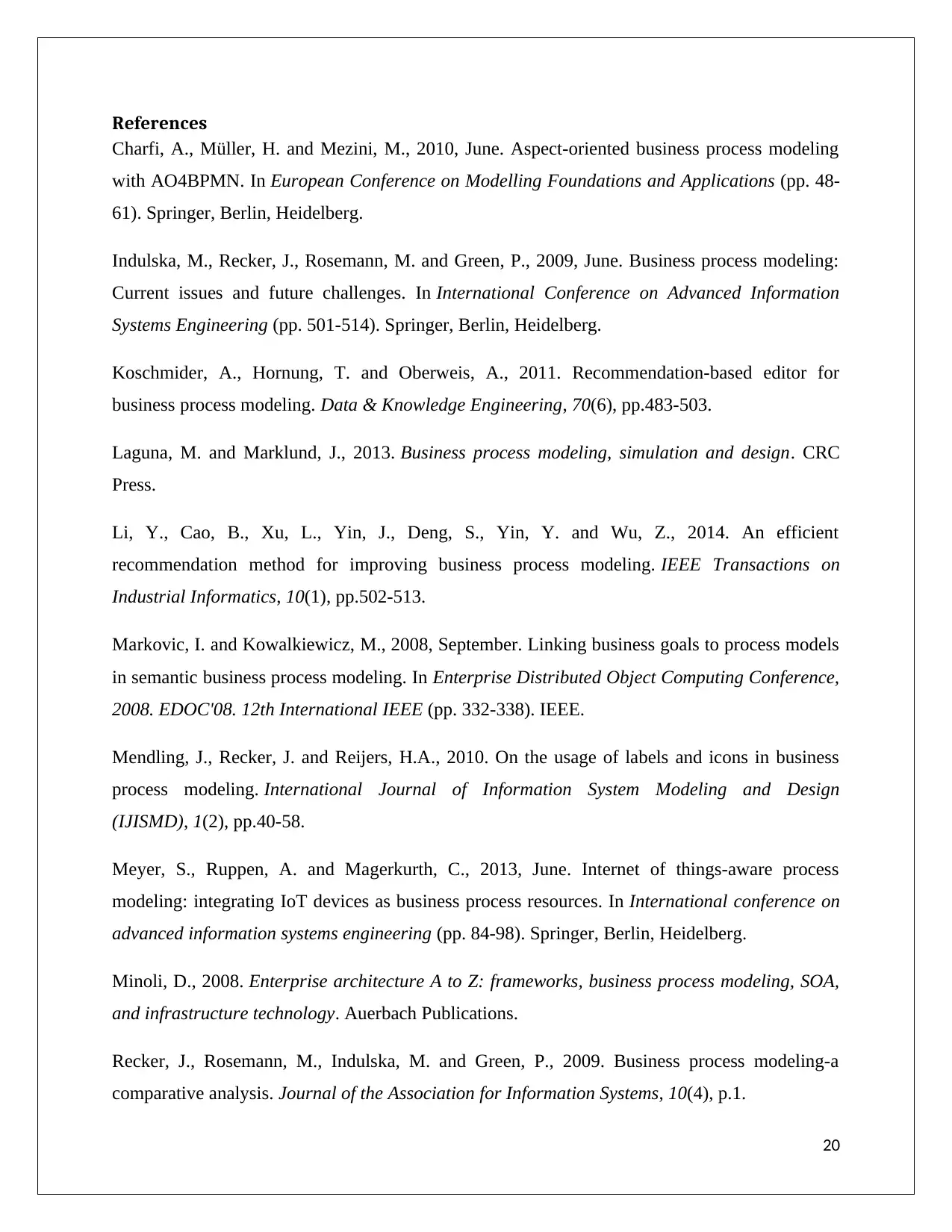
References
Charfi, A., Müller, H. and Mezini, M., 2010, June. Aspect-oriented business process modeling
with AO4BPMN. In European Conference on Modelling Foundations and Applications (pp. 48-
61). Springer, Berlin, Heidelberg.
Indulska, M., Recker, J., Rosemann, M. and Green, P., 2009, June. Business process modeling:
Current issues and future challenges. In International Conference on Advanced Information
Systems Engineering (pp. 501-514). Springer, Berlin, Heidelberg.
Koschmider, A., Hornung, T. and Oberweis, A., 2011. Recommendation-based editor for
business process modeling. Data & Knowledge Engineering, 70(6), pp.483-503.
Laguna, M. and Marklund, J., 2013. Business process modeling, simulation and design. CRC
Press.
Li, Y., Cao, B., Xu, L., Yin, J., Deng, S., Yin, Y. and Wu, Z., 2014. An efficient
recommendation method for improving business process modeling. IEEE Transactions on
Industrial Informatics, 10(1), pp.502-513.
Markovic, I. and Kowalkiewicz, M., 2008, September. Linking business goals to process models
in semantic business process modeling. In Enterprise Distributed Object Computing Conference,
2008. EDOC'08. 12th International IEEE (pp. 332-338). IEEE.
Mendling, J., Recker, J. and Reijers, H.A., 2010. On the usage of labels and icons in business
process modeling. International Journal of Information System Modeling and Design
(IJISMD), 1(2), pp.40-58.
Meyer, S., Ruppen, A. and Magerkurth, C., 2013, June. Internet of things-aware process
modeling: integrating IoT devices as business process resources. In International conference on
advanced information systems engineering (pp. 84-98). Springer, Berlin, Heidelberg.
Minoli, D., 2008. Enterprise architecture A to Z: frameworks, business process modeling, SOA,
and infrastructure technology. Auerbach Publications.
Recker, J., Rosemann, M., Indulska, M. and Green, P., 2009. Business process modeling-a
comparative analysis. Journal of the Association for Information Systems, 10(4), p.1.
20
Charfi, A., Müller, H. and Mezini, M., 2010, June. Aspect-oriented business process modeling
with AO4BPMN. In European Conference on Modelling Foundations and Applications (pp. 48-
61). Springer, Berlin, Heidelberg.
Indulska, M., Recker, J., Rosemann, M. and Green, P., 2009, June. Business process modeling:
Current issues and future challenges. In International Conference on Advanced Information
Systems Engineering (pp. 501-514). Springer, Berlin, Heidelberg.
Koschmider, A., Hornung, T. and Oberweis, A., 2011. Recommendation-based editor for
business process modeling. Data & Knowledge Engineering, 70(6), pp.483-503.
Laguna, M. and Marklund, J., 2013. Business process modeling, simulation and design. CRC
Press.
Li, Y., Cao, B., Xu, L., Yin, J., Deng, S., Yin, Y. and Wu, Z., 2014. An efficient
recommendation method for improving business process modeling. IEEE Transactions on
Industrial Informatics, 10(1), pp.502-513.
Markovic, I. and Kowalkiewicz, M., 2008, September. Linking business goals to process models
in semantic business process modeling. In Enterprise Distributed Object Computing Conference,
2008. EDOC'08. 12th International IEEE (pp. 332-338). IEEE.
Mendling, J., Recker, J. and Reijers, H.A., 2010. On the usage of labels and icons in business
process modeling. International Journal of Information System Modeling and Design
(IJISMD), 1(2), pp.40-58.
Meyer, S., Ruppen, A. and Magerkurth, C., 2013, June. Internet of things-aware process
modeling: integrating IoT devices as business process resources. In International conference on
advanced information systems engineering (pp. 84-98). Springer, Berlin, Heidelberg.
Minoli, D., 2008. Enterprise architecture A to Z: frameworks, business process modeling, SOA,
and infrastructure technology. Auerbach Publications.
Recker, J., Rosemann, M., Indulska, M. and Green, P., 2009. Business process modeling-a
comparative analysis. Journal of the Association for Information Systems, 10(4), p.1.
20

Weske, M., 2012. Business process management architectures. In Business Process
Management (pp. 333-371). Springer, Berlin, Heidelberg.
21
Management (pp. 333-371). Springer, Berlin, Heidelberg.
21
1 out of 21
Related Documents
Your All-in-One AI-Powered Toolkit for Academic Success.
+13062052269
info@desklib.com
Available 24*7 on WhatsApp / Email
![[object Object]](/_next/static/media/star-bottom.7253800d.svg)
Unlock your academic potential
© 2024 | Zucol Services PVT LTD | All rights reserved.




